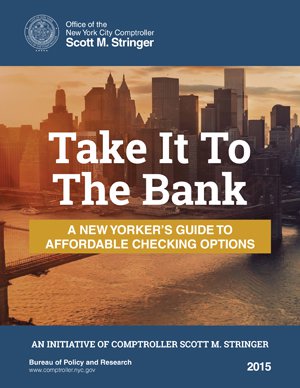Take It to the Bank
A New Yorker’s Guide to Affordable Checking Options
Bank accounts come with many benefits. Even the most basic bank account gives consumers a secure place to deposit their hard earned wages, grow their savings, pay bills, accrue credit, and manage their own money. From the teenager with his or her first summer job to the near-retiree carefully tending their finances, bank accounts give consumers control over their own financial lives.
Unfortunately, too many New Yorkers do not share in the benefits of banking. While New York City is the financial capital of the world, an estimated 825,000 adults in New York City lack even a basic checking account. This amounts to 13 percent of all City households, well above the national rate of 7.7 percent. In some neighborhoods like Mott Haven and Melrose in the Bronx, over half of all residents are classified as “unbanked.”
All New Yorkers should be able to reap the benefits of participating in the banked economy. And for the unbanked and underbanked, access to an affordable account can save hundreds of dollars per year compared to costly alternative financial services like check-cashing. However, deciding which account best suits one’s needs can be a daunting task and obtaining comprehensive information about the features and fees associated with accounts can be challenging for the average consumer.
Take it to the Bank, by New York City Comptroller Scott M. Stringer, is designed to make that process easier by providing extensive information on basic banking products in one place. The 74 checking accounts surveyed in this report – one account per featured bank – have the lowest opening deposit and monthly maintenance fees among each bank’s product offerings, making them an accessible entry point to banking for many New Yorkers. This report profiles 74 different FDIC-insured banks that offer retail services in New York City, and shares data on 34 different features, fees and attributes of each bank.
Offering by far the most comprehensive review of basic bank accounts currently available to local consumers, the report assembles and interprets over 2,500 separate data points relating to bank features and policies. In addition, this information is available in an interactive online search tool at www.takeittothebank.nyc, which makes it easier than ever for New Yorkers to take a second look at their existing accounts, or open an account for the first time.
Take it to the Bank aims to promote transparency in consumer banking by highlighting the factors that are most important to everyday New Yorkers. A 2011 Pew Trust study of checking accounts found that among 265 checking products surveyed, the median disclosure statement included 111 pages of fine print. Buried within that mountain of legalese is crucial information about fees, account benefits rules, and bank procedure. For the first time in New York City, this report brings that information out into the open.
To help consumers further navigate the diversity of checking options available in New York City, this report provides an at-a-glance assessment of the most affordable bank accounts available to consumers. Accessing the fees, costs, and policies associated with each account is intended to help New Yorkers quickly identify bank accounts with the most competitive combination of features and policies.
Some key findings of the report include:
- For a low balance customer, the average cumulative cost of maintenance and transaction fees amounted to $73 per year.
- The combined initial opening deposit requirement and the estimated cost of utilizing a ‘basic’ bank account ranged from $0 to $500 per year for a low balance consumer, according to a model developed by the Comptroller’s office.
- 28 percent of banks did not appear to offer or widely advertise a “basic banking” (also known as Lifeline) account, as is required under New York State law.5 Failing to promote these accounts makes finding an affordable entry point into banking all the more difficult for New Yorkers.
- Among the 20 banks offering the most affordable combination of fees and opening deposits, the vast majority (90%) are banks with 25 branches or fewer. This finding suggests that the bank on your block might not be the best bank for your buck.
- Only 28 percent of banks are currently accepting the City’s new municipal ID card, IDNYC, as a valid form of identification with which to open an account.
Understanding banking options is critical for today’s consumer. The percentage of banks with more than $50 billion in assets that offered free checking declined from 96 percent in 2009 to 41 percent in 2011. Furthermore, in 2013, the nation’s banks took in an estimated $31.9 billion from overdraft fees alone, while monthly maintenance fees continue to rise.
More locally, there are clearly steep challenges to overcome in providing all New Yorkers with safe, accessible and affordable banking services. The City’s Community Investment Advisory Board (CIAB) recently found that there are 1.2 branch locations for every 1,000 residents in areas with a majority-minority population, compared to 3.6 locations per 1,000 residents in areas that are majority white.8 In addition, the Bronx has the lowest concentration of bank branches per household of any county in the nation, while also having the lowest median household income in the five boroughs.
Take it to the Bank is the latest in a series of reports designed to increase transparency and accountability in the financial services industry, a bulwark of the New York City economy. In March 2015, Comptroller Stringer issued Safeguarding our Savings, which called for federal and state action to hold financial planners to the “fiduciary standard”—which dictates that advisors act in the best interests of clients—or, where planners are subject to a lower standard, to disclose that in plain language to clients.
